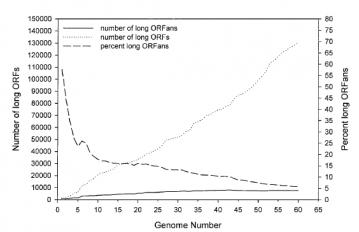Molecular homology is an important concept in modern evolutionary biology, used to test the relationships between modern taxa, and to examine the evolutionary processes driving evolution at a molecular level. It is a rapidly changing field, and one that students who wish to "explore evolution" should surely understand. Explore Evolution will not provide that understanding.
The book focuses too narrowly on peripheral topics, without giving students an appreciation of the techniques and concepts central to molecular biology and molecular systematics. Explore Evolution only considers homologies in DNA sequence, but scientists also examine homologous amino acid sequences in proteins (which can result from several different DNA sequences), and homologous protein folds (which can result from numerous different amino acid sequences). Before it was practical to sequence genomes, scientists also used simpler measures like molecular size and electrical charge to identify similarities and differences between molecules.
Rather than surveying this range of homologies, Explore Evolution focuses on a few minor points: the consistency of the code for translating between nucleic acids and amino acids, the ability to estimate the timing of evolutionary divergence based on molecular divergence, modest and predictable differences between the patterns of homology in different genes, and genes that seem to have no homologs in other species. In each case, the account given is misleading and inaccurate, reflecting creationist misconceptions rather than the best science.
p. 58: "Biologists have long thought that the genetic code is basically the same in all organisms."
Since the genetic code was first identified, biologists knew that small variants were possible, and existed. Such small variants do not undermine the basic consistency of the code.
p. 59: "advocates of universal common descent have always assumed that a change in code was not survivable"
Scientists have known that the code does vary since at least 1968. Such variants do not undermine the evidence for common ancestry, and understanding the mechanism by which such variants evolve strengthens the evidence for a common source of the genetic code.
p. 58: "It's very hard to see how an organism could have survived a transformation from the standard code"
Mechanisms for this transformation are understood and have been studied in the lab.
p. 57: "A 'family history' of organisms based on their anatomy should match the 'family history' based on their molecules"
There are many well-studied evolutionary processes that can cause a molecular phylogeny to differ from a phylogeny based on anatomy. These well-understood processes are unmentioned.
p. 57: "Michael Lynch has noted that creating a clear picture of evolutionary relationships is 'an elusive problem'"
Lynch was not referring to all evolutionary relationships, only to distant evolutionary connections. He explains: "Given the substantial evolutionary time separating the animal phyla, it is not surprising that single-gene analyses yield discordant results." In such distant relationships, "Statistical noise" can make "inferences based on single genes very misleading."
p. 58: "Carl Woese now thinks that biology must abandon what he calls Darwin's 'Doctrine of Common Descent'"
Woese is engaged in a technical dispute which Explore Evolution misrepresents consistently. Woese does not question the common ancestry of all animals and plants, nor does he think it unlikely that all modern life descended from a common population of organisms with extensive gene swapping. This is a different form of common ancestry, not a rejection of common ancestry in all forms.
p. 57: "the rate of mutation varies in response to a number of environmental factors"
The citation offered to justify this claim offers no support. The claim is a staple of creationist writings, but has no basis in modern evolutionary biology.
 Parents for ORFans: Ongoing research finds homologues for supposed ORFans
Parents for ORFans: Ongoing research finds homologues for supposed ORFans p. 60: "a large number of genes code for proteins whose functions we don't understand ORFan genes"
This is not how ORFans are defined. Some have known functions, others do not code for proteins. While coding sections of DNA with no known homologues were identified early in whole-genome sequencing, continued sequencing efforts have revealed homologues for ever more such sequences.
p. 61: "conflicting phylogenetic trees or ORFans undermine Universal Common Descent"
Modern evolutionary biologists have addressed these issues, and the incomplete and inaccurate account in Explore Evolution fails to address the current state of the science, or current thinking on the shape of the tree of life.
p. 61: "Michael Syvanen Michael Gordon"
Syvanen and Gordon have explored some possible alternative shapes for the tree of life, but neither scientist has changed the state of scientific opinion, nor do either challenge the basic principles of common ancestry of all animal and plant life, or the likelihood that all life descends from a united population of cells at some point, however many lineages entered that population.
Major Flaws:
A Universal Tree of Life: The scientists cited by Explore Evolution do not dispute that multicellular life shares a common ancestry, nor the likelihood that all modern life descended from a single population of ancient organisms that swapped their genes widely.
Evolving Codes and Novel Genes: Explore Evolution cites minor variations in the universal genetic code to undermine common ancestry. The mechanisms behind such variations are well-understood and in fact strengthen our understanding of common ancestry. ORFans, sections of DNA that have the structure of genes but lack homologues in other species, do not undermine claims of common ancestry. As new genomes are sequenced, ever more homologues are found.
Molecular Clocks: Common ancestry, contrary to the claims in Explore Evolution, is not dependent on molecular clocks. Nonetheless, some potential problems cited by the book have been addressed by working scientists. Others are based on creationist misconceptions about molecular clocks, and simply lack scientific basis.
